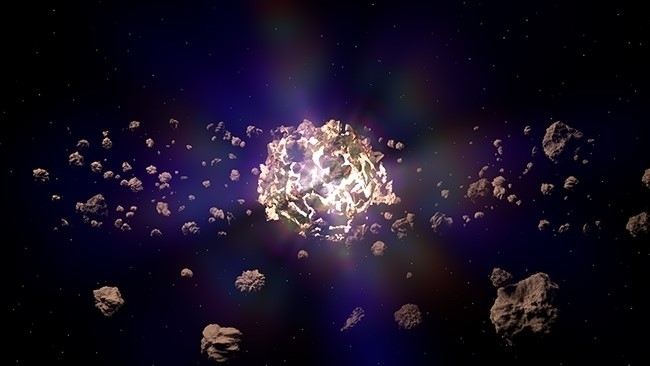

Artist’s representation of asteroid formation from the disintegration of a precursor object (credit: Safwan Aljbaae/MASB)
Based on artificial intelligence techniques such as neural networks and machine learning, the system takes seconds to perform tasks that used to take months. It will extract useful information from the gigantic amount of data furnished by the new Vera C. Rubin telescope.
Based on artificial intelligence techniques such as neural networks and machine learning, the system takes seconds to perform tasks that used to take months. It will extract useful information from the gigantic amount of data furnished by the new Vera C. Rubin telescope.

Artist’s representation of asteroid formation from the disintegration of a precursor object (credit: Safwan Aljbaae/MASB)
By José Tadeu Arantes | Agência FAPESP – Next-generation telescopes will produce an explosion in knowledge of the Universe – both more distant, and hence older objects, and those relatively close to Earth in the Solar System. An example is the Vera C. Rubin Observatory, which is expected to begin operating in a year’s time on a summit located 2,681 meters above sea level on Cerro Pachón in northern Chile. Rubin Observatory, as it is known, will house a wide-field reflecting telescope with an 8.4-meter primary mirror, and a camera the size of a small car with six optical filters and 189 sensors for a combined 3,200 megapixels. With these resources, it will capture images of the entire visible sky every three to four nights and will be able to operate every night for at least ten years. It could potentially unveil 20 billion galaxies and enable scientists to identify up to 2 billion new objects in the Solar System.
The discoveries will include a huge increase in the number of known asteroids, with vast masses of data on physical composition, orbital motion and classification into families. To help process the enormous volume of data, researchers in Brazil affiliated with Machine-learning Applied to Small Bodies (MASB https://valeriocarruba.github.io/Site-MASB/), a group led by Valerio Carruba, a professor in the Department of Mathematics at São Paulo State University’s Guaratinguetá School of Science and Engineering (FEG-UNESP), have developed artificial intelligence (AI) resources that cut the time taken to analyze and classify asteroid orbital dynamics from months to seconds.
An article describing their research (“Optimization of artificial neural networks models applied to the identification of images of asteroids’ resonant arguments”) was published in December 2022 in the journal Celestial Mechanics and Dynamical Astronomy and is slated to win a prize for “Innovative computational methods in dynamical astronomy” at the Eighth International Meeting on Celestial Mechanics. in Rome this September.
“We tested three different artificial neural networks to analyze and classify images referring to asteroid orbital dynamics,” Carruba told Agência FAPESP. “This task used to be done visually by comparing astronomical images collected on different dates and took weeks or even months. We now perform it in a few seconds using these new computational techniques. In the study, we identified weaknesses in the three networks investigated, selected and upgraded the best network, and discovered new young asteroid families.”
Classification of asteroids into families is based on shape, size and orbital inclination in relation to another celestial body. “At the time an asteroid family is formed, all pericenters [points at which the trajectories come closest to the Sun] and ascending nodes [points at which orbits pass upwards through a reference plane] are aligned. Over time, the alignment is lost owing to gravitational disturbances produced by planets or massive asteroids. The computational techniques can be used to go back into the past as far as the time when the parameters were aligned, if the family was formed in approximately the last 7 million years, and thereby characterize the family,” Carruba explained.
An asteroid collision can lead to the fragmentation of one or both bodies, giving rise to a family with several objects. Families can also be formed by fission, in which an asteroid breaks up owing to rapid rotation or collision.
Asteroids are relics of the beginnings of the Solar System about 4.5 billion years ago and of violent reconfigurations that have happened since, owing to gravitational disturbances produced by formation of the giant planets, especially Jupiter and Saturn. Because of these complex dynamics, large numbers of smaller bodies are currently concentrated in two regions: the Main Asteroid Belt between Mars and Jupiter; and the Kuiper Belt, which extends beyond Neptune’s orbit.
NASA, the United States space agency, has counted 1,298,691 asteroids, based on the observational data available so far. This is already a very large number, but it is set to rise significantly as a result of the new images of the sky that will be captured by Rubin Observatory.
The name is a tribute to an outstanding scientist who was not recognized as such in her own lifetime. Among her various contributions to science, US astronomer Vera Cooper Rubin (1928-2016) pioneered the study of spiral galaxy rotation curves. She showed that the outermost components of these galaxies were moving as quickly as those close to the center and that a large amount of unseen mass must be holding them together, as the gravity of their stars was insufficient to do so. This discrepancy is considered one of the main indications of the existence of dark matter.
The study was partially supported by FAPESP via a scientific initiation scholarship awarded to Marcos Vinicios Faria Lourenço, one of Carruba’s students.
The article “Optimization of artificial neural networks models applied to the identification of images of asteroids’ resonant arguments” is at: link.springer.com/article/10.1007/s10569-022-10110-7.
Republish
The Agency FAPESP licenses news via Creative Commons (CC-BY-NC-ND) so that they can be republished free of charge and in a simple way by other digital or printed vehicles. Agência FAPESP must be credited as the source of the content being republished and the name of the reporter (if any) must be attributed. Using the HMTL button below allows compliance with these rules, detailed in Digital Republishing Policy FAPESP.





